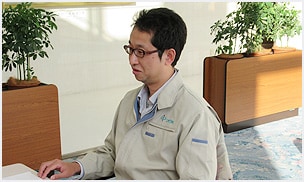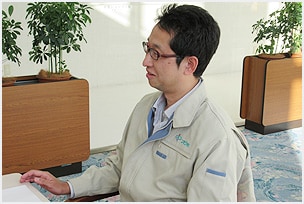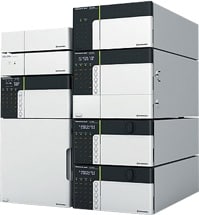
Food and Beverages

INDUSTRY
Food and Beverages, Small Molecule Pharmaceutical
KEYWORD
INTRODUCTION SERVICE&PRODUCTS
API Co., Ltd. manufactures, sells, researches, and develops bee products, such as honey, royal jelly, and propolis products. In addition, API is involved in developing other businesses, such as manufacturing health foods and pharmaceuticals, and supplying raw materials for such products, on a contract basis. This article is based on an interview with a user at API's Nagaragawa Research Center that uses a Nexera X2 ultra high performance liquid chromatograph.

Mr. Kenji Kato
Chief, Analytical Chemistry Group, Nagaragawa Research Center
*Affiliates and titles of the interviewee are current as of the time of reporting.
API Co., Ltd.
URL
http://www.api3838.co.jp/en/index.html
What was the background, motivation, and key selection criteria for purchasing the Nexera X2 ultra high performance liquid chromatograph for food analysis?

Well, we needed an LC system able to achieve high resolution. Because our samples come from nature, they contain large amounts of contaminant components, in addition to the principal components. Therefore, we need to separate the principal components with high reproducibility. For example, in some cases, we need to separate a specific component from 1000 other components contained in the sample. Consequently, the most important criteria were high sensitivity and high resolution.
The ability to analyze samples with high resolution is more important than that with ultra-high speed. Is that right?
Yes, we use an ultra-high-speed resolution column with an analysis time of about 15 to 20 minutes and then try to determine the analytical conditions that maximize resolution. Consequently, our analysis is not ultrafast, but the ability to reduce the analysis time from one hour using a regular HPLC system to less than half the time using the Nexera X2 is a huge benefit.
I suppose that approach also provides higher resolution, doesn't it?
Yes. Of course, reducing the analysis time is important. Given the rapid pace of changes in the food industry, we often have only a week or two available to establish methods for everything from pretreatment of new ingredients to analysis. That's why we need a UHPLC system that can evaluate a large number of analytical conditions within as short a time as possible.
UHPLC systems tend to have a reputation for only being suitable for experts. However, due to the high basic performance of the Nexera X2, I think it is well suited to even inexperienced operators. That's because it simultaneously offers both high speed and high reproducibility.

Thank you so much. In the past, UHPLC had a reputation for being fast, but not very good in terms of resolution and reproducibility. The Nexera series represents the development team's unified effort to create a UHPLC system that does not sacrifice basic performance.
The ability to detect substances with high sensitivity is important. When evaluating the absorption characteristics of food components, particularly for trace quantities of components with functional benefits, it is extremely difficult to detect components that have been further diluted inside the body. Also, biologically derived samples, such as blood, are often only available in very small quantities. That requires high-sensitivity analysis of small injection volumes. That is why we were so hopeful when we heard that the Nexera X2 is able to detect 100 pg/mL to 1000 pg/mL concentrations of target components in sample injection volumes less than 10 μL.
We also needed the automatic pretreatment functionality of the autosampler. We considered using derivatization analysis with fluorescence detection for high-sensitivity analysis of substances in the brain, amino acids, and so on. The automatic pretreatment functionality also enables operators to create calibration curves automatically, which reduces the amount of work required by operators during quantitative analysis.
For what types of work do you use the Shimadzu HPLC system?
To start, we use it in raw material development and product development work. That involves quantitatively analyzing indicator components contained in the raw ingredients of food products and evaluating variations in components after processing the raw ingredients. We also use the HPLC system to evaluate whether or not the quantity of active ingredients decreased after conversion to a powder or drug product and for dissolution testing of drug products. Then there is also absorption testing. Absorption tests evaluate the quantity of active ingredients absorbed by the body and the changes in that quantity over time. Furthermore, we use the HPLC system for quality control, to evaluate the stability of components in accelerated testing.
In actual practice, what types of samples do you typically analyze?
Typically, we analyze bee products, such as royal jelly, propolis, honey, and bee pollen, or compounds with low or high molecular weight contained in general food ingredients.
In terms of the form of samples, we test liquid ingredients, freeze-dried and other powdered ingredients, soft and hard capsule formulations, drink formulations, and so on.
What is your impression of the Nexera X2 system after using it in actual operations?

As anticipated, it has allowed us to perform high-speed analysis with high resolution.
We can now obtain chromatograms comparable to those from existing HPLC systems in one fourth the time. We use it for about 3000 to 4000 injections per year, including for method scouting and routine analysis.
Due to the high reproducibility, we have been obtaining very reliable analytical results. Day-to-day differences in retention times and quantitation values from quantitative analysis have been within 1 %. This has been especially beneficial for gel permeation chromatography (GPC) analysis, where a 0.01 minute retention time difference can have a major effect on molecular weight. Consequently, we are able to prepare reports with confidence.
In addition, the baseline is very stable, especially for analysis at high wavelengths. We also often analyze pigments; the Nexera X2 provides a more stable baseline and higher sensitivity in the 400 to 800 nm wavelength range than LC products from other companies. The difference from competing products is especially apparent during absorption testing, when sensitivity is particularly crucial.
The large column oven accommodates a wide range of column sizes, heats up quickly, and maintains very stable temperatures.
So you say that columns are easy to install and that the oven provides a sense of security that columns won't leak during analysis?
Yes. Though a wrench is used to tighten column connections, it is easy to do once you get the hang of it. Also, there is no worry of leakage, which is especially helpful for gradient analysis. That's because, even if a column does not leak when installed, columns are prone to leak when the pressure increases during gradient analysis. If you fail to notice the leakage, then you end up having to repeat the analysis.

Another benefit is the ability to reduce the quantity of solvents used.
The Nexera X2 uses only about a third of the solvent used by regular LC systems. We appreciate the reduction in cost and trouble that has resulted from purchasing solvents and preparing mobile phases less often. That is also important in terms of protecting the environment.
If you use the system daily, as you say, then product robustness is also important, isn't it?
For our company, which must perform a wide variety of analyses, from analyzing raw ingredients for foods to absorption testing, we operate our LC systems every single day. Given our situation, losing even one day of analysis due to a breakdown or repair is the one thing we want to avoid the most. Therefore, product robustness is extremely important.
When we were considering whether to purchase the Nexera X2 system, the distributor strongly recommended it. Also, the feedback from other sites with the Nexera X2 was that it does not break down and that service support is excellent. Another big factor was that our Shimadzu Prominence system has not failed in over ten years.
What do you think about the service support we have provided since you purchased the system?
We feel the support from Shimadzu has been good. We also felt the explanation of maintenance requirements when the system was installed was easy to understand. We were able to understand how to check functionality after replacing parts, such as checking the gradient and reproducibility using a standard sample (caffeine). With competing products, a representative only explained how to replace parts, and an actual sample was not used to check functionality. Also, Shimadzu has responded quickly to any problems by coming the same day, which is very reassuring.
Do you have any comments or requests regarding the Nexera X2 that you'd like to share?
We do not need faster speed or higher pressure capacity than it currently has. In fact, many people that have used both existing and ultra-fast LC models feel that analysis would be preferable at an intermediate point on the time axis. The Nexera X2 offers good broad applicability as a UHPLC system able to perform analysis at either high or low speeds and either high or low pressures.
In terms of our requests for the product, we would prefer that the system had a pH resistance up to pH 12. In actual practice, it is extremely rare for us to use highly alkaline mobile phases, but it would be nice if the system could be rinsed with an alkaline solution after protein-based analysis.
We also wish you would develop a column with a good S/N ratio, and we want a column that retains water-soluble components, such as organic acids and amino acids.
Column performance is still important for obtaining beautiful chromatograms with clearly separated target components. I am hoping Shimadzu will develop a resolution column based on the ghost trap technology they recommended.
Do you have any particular expectations for Shimadzu products?
We expect using the Shimadzu GC-MS system will allow us to expand our options for analysis. We would like to use the system for identifying unknown components and analyzing lipophilic components, once acquired. We also want to analyze metabolites using the system.
Thank you for providing your valuable time with us today.


Nexera X2 Ultra High
Performance Liquid Chromatograph
This interview at API provided a reminder of how important high resolution is for LC analysis in the food industry. We also learned that API is maintaining a high system usage rate by using the system for a variety of analytical applications. There was a strong sense of how much they appreciate the performance reliability and reproducibility, which is uniquely characteristic of the Nexera X2.
We hope others in the food industry will experience the high-quality, high-speed, and high-resolution analytical performance of the Nexera X2 for themselves.
In this interview, we also received comments about developing new products, including columns, based on the keyword "beautiful chromatogram." We are committed to supplying products that provide high-quality data and to following up with superior service support.